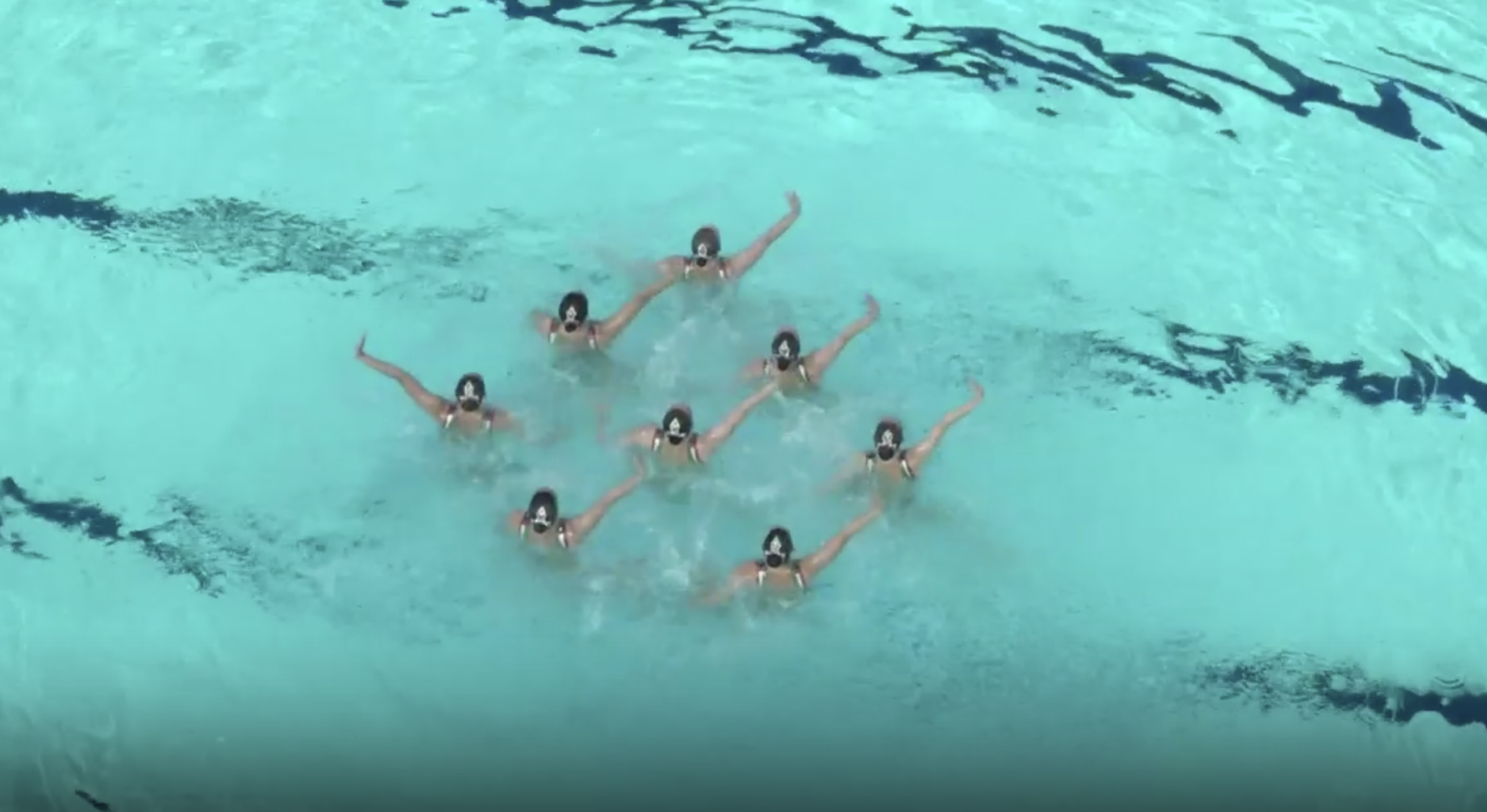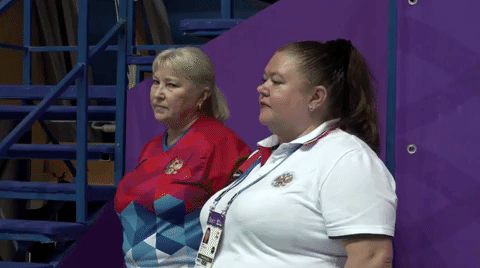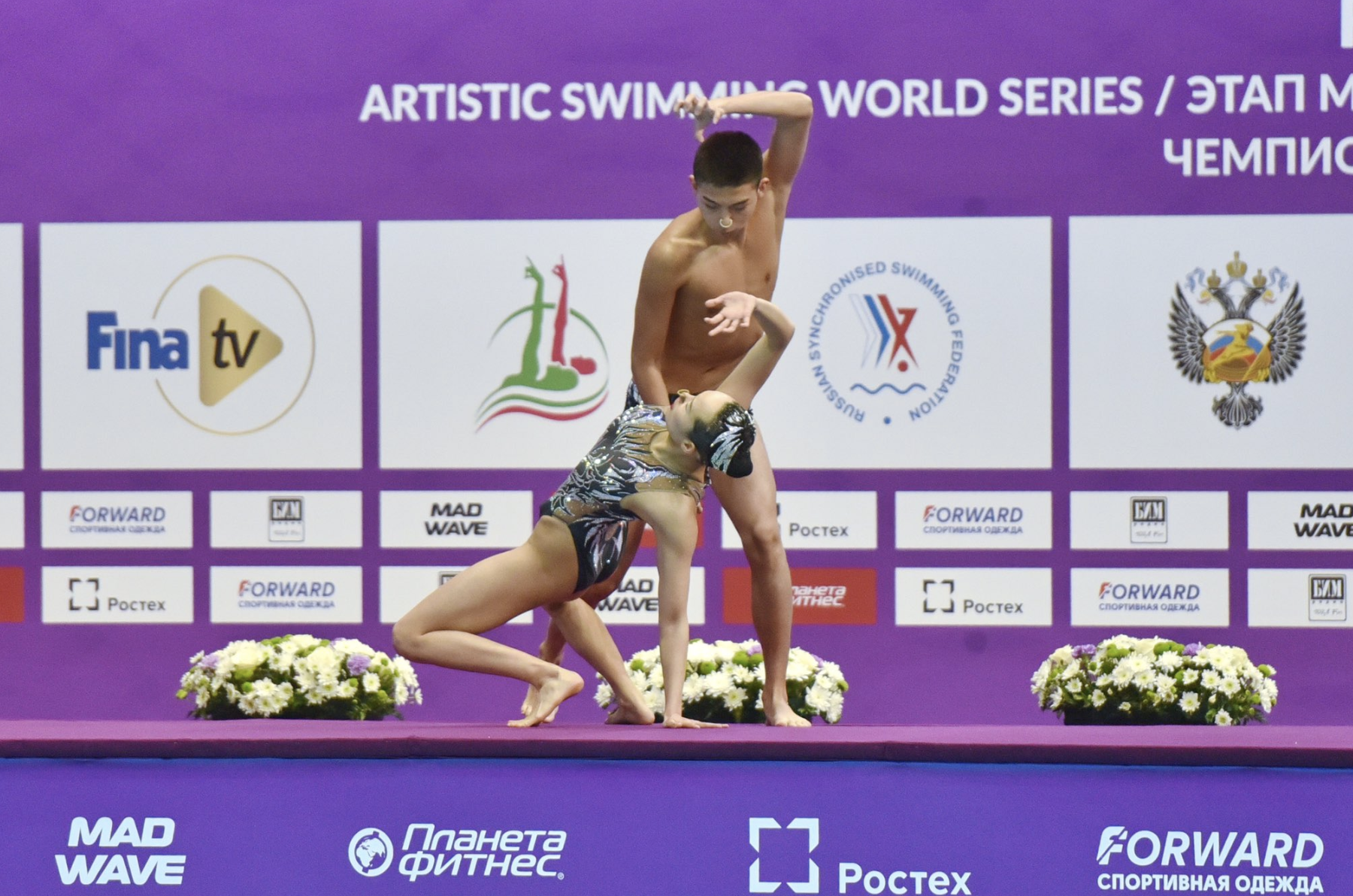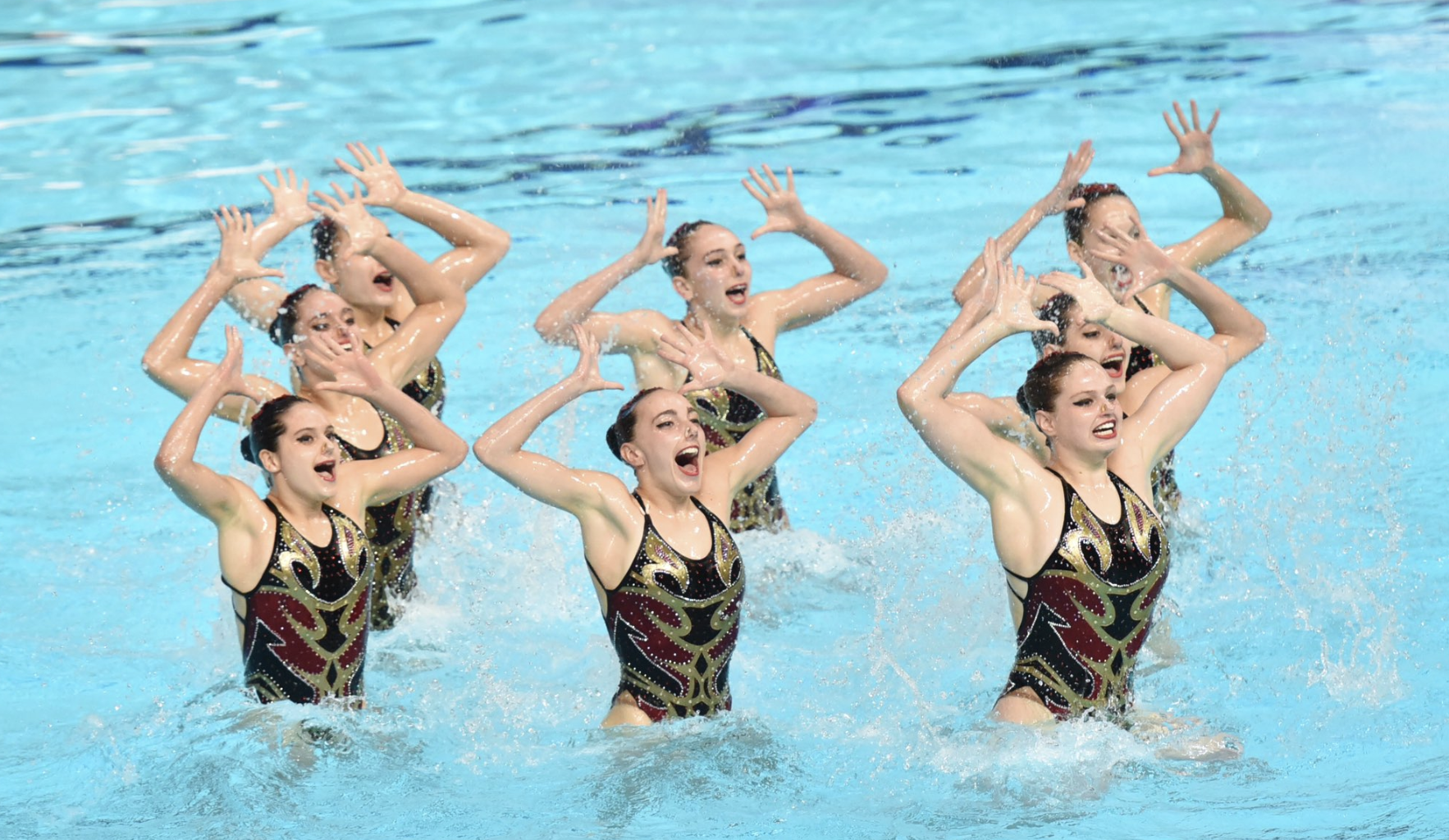Svetlana Romashina is amongst the legends of our sport, currently tied for most Olympic gold medals with five total, and now she’s back for more after a nearly three-year hiatus. She took a break from the pool after winning the team and duet events at the 2016 Olympic Games, became the mother of an adorable little girl, and announced her decision to come back to competition in the fall of 2018.
Romashina and Svetlana Kolesnichenko competed together again in the duet event for the first time since 2013. Kolesnichenko had been moved up to the duet back then as Natalia Ischenko was going through her own hiatus and pregnancy before her comeback (sounds familiar, eh?).
The two unveiled a new technical routine where they and their coach Tatiana Danchenko went all in with the Japanese theme as they swam to the dance/electronic song “Wamono” by HIFANA. Despite a little mishap from Romashina in the walk-in and deckwork, the two looked fantastic together. It’s incredible to think Romashina was away from training and competition for three years and is able to come back to the same level. They won gold (duh) with a big 96.1481, nearly matching Russia’s tech score at the 2016 Olympics. Scores in technical duet were relatively high for everyone, with essentially a lot of nations recording career-highs, but at least it was consistent throughout.
In the free duet, the two re-used the Aliens routine, albeit simplified and modified, that we had only seen for one season in 2015 with Romashina and Ischenko. Moving past the disappointment of the recycling of an old routine, this decision indeed makes sense for this competition. It was probably necessary to ease Romashina back into it all, and the priority had to be on the technical routine with the new technical elements that she had never competed before, as they changed after the 2017 season. Then, the routine itself was only used for one season as mentioned above, and re-using it is a better call than using the Mermaids routine for a fourth year in a row. Finally, Kolesnichenko was already alternate to the duet back in 2015, and probably remembered the choreography too. We can however rejoice, as they said in a post-meet interview that they will have a surprise in store for us at the world championships and should have a new free choreography by then.
Romashina’s comeback was not the only one of note at this meet. In the team events, Alla Shishkina, a two-time Olympic champion, was also returning. Similarly to Romashina, Shishkina had taken a break after the 2016 Olympics, and she looked just as fantastic as her Olympic teammate. Moreover, 2016 Olympian Vlada Chigireva was also back in the pool after missing the entire 2018 season with a knee injury.
The technical team routine was new, which was much needed after three years. This new routine uses Russian folklore “Quadrille” music, which is very fast paced. The first throw is absolutely insane, where the flier grabs her leg into a full split halfway through the jump. There were small sync errors on the first two elements, but the cadence action was to die for.
The big and very silly mistake came however with the ending pose, where one swimmer did not put the correct arm up. And since we are in the technical event and everything essentially has to be the same at all times, there went 0.5 penalty point.

The free team was once more the Shamans, although they tried to fool us by changing swimsuits. The routine was very clean, which better be if you’re going to swim it for the third year in a row, and as impressive and superb as ever. However, we once more had a tiny mishap towards the start as one swimmer put her noseclip back on in the middle of an arm segment. She did it very smoothly, and the routine is so fast and packed that she may not have had the time to do it underwater before the next hybrid. However, the coaches probably wished she had done that instead because they did not look impressed after the swim. That look straight into the camera like we are in an episode of The Office absolutely gets me. “Did you just see this?”

Overall, the Russians here were maybe just a bit nervous and tight for their first outing of the season, and made a lot of strange, weird mistakes we are not used to seeing from them: lost noseclip, obvious arm error resulting in a penalty, and a forgotten deckwork choreography. However, I am zero percent worried about them and I am sure they will continue dominating for the rest of quad, but it does make them look maybe more vulnerable and relatable.
Despite all of that, this Russian team however looked already much stronger than in the last few years, with the returns of Shishkina and a healthy Chigireva, and the addition of Varvara Subbotina in free, who needs no introduction. With the addition of Romashina and Kolesnichenko for the Olympic year, the team roster will be incredibly stacked and invincible.
Kolesnichenko also competed in the technical solo event with a new routine set to ‘Survivor’ from 2WEI, from the Lara Croft soundtrack. It was a clean, sharp routine, that scored 92.8144, a score that is relatively low for her own standards. However, scores in technical solos particularly on the elements were all over the place for most swimmers. For example, Kolesnichenko’s barracuda element ranged from 8.0 to 9.7, which is not even close to being the same quality of element at all. Just like in the technical duet, at least those crazy ranges were consistent for most soloists. As for Romashina, she is set to compete in the free solo at worlds.
In the mixed duet events, Aleksandr Maltsev and Mayya Gurbanberdieva competed the same two routines we saw from them at the 2018 European Championships, i.e. the tango technical routine, and the ‘Sing Sing Sing’ free routine. Coach Gana Maksimova has however already revealed that they are preparing a new technical routine for worlds that they don’t want to unveil yet. Hopefully, we will also see a new free routine as it’s already been its third season, but Maksimova did not mention anything to the press.
Before moving on from Russia, it is also worth checking out the free combination routine from Moscow that won that event with a 92.5333. If you only have time to watch one routine from the Russian Nationals portion of this event, it’s this one, and it’s incredible as the score speaks for itself. All are junior swimmers, but more than half of the roster of that team is the future, so keep your eyes out for them.
Italy‘s Linda Cerruti and Costanza Ferro swam their new technical duet, and it is attention-grabbing from the start. The first lap and music is intense, very reminiscent of some opening laps from Russian routines, before moving on to a softer music portion. They won silver with 89.8612.
The Alexandri sisters from Austria made their season debut in Kazan in the technical events, and finished only two points behind Italy in duet, which is a fantastic and encouraging way to start the season. Anna Maria and Eirini Alexandri kept the same choreography as last season, and recorded a career-best score of 87.7417, which is certainly a great starting point. Vasiliki Alexandri did debut a new technical solo set to “The Storm” by HAVASI and won silver.
Continuing with technical duets, Belarus had its two duets compete against each other for the first time on the international scene. The new pair of Vasilina Khandoshka and Daria Kulagina came out on top, just like at nationals a few weeks ago, by 1.4 points ahead of the veteran duet of Olympian Iryna Limanouskaya and Veronika Yesipovich. The score of 84.8887 they obtained could also very well challenge for a final at worlds and tickle the hierarchy.
Kulagina competed for Russia in the junior national team, and both do actually train in Moscow with Elena Voronova… who also helps coach Kolesnichenko and Romashina’s duet alongside Tatiana Danchenko. It all comes back to Russia, doesn’t it? Voronova actually choreographed both duet routines for Khandoshka and Kulagina. It will be interesting to see what the Belarusian federation decides to do moving forward and which duet it selects for worlds. Khandoshka and Kulagina also competed in the free duet event, and obtained a big 86.8000, once again a score that could come challenge the likes of France, the Netherlands, Mexico, the U.S., or even Austria.
Another swimmer training in that same Moscow club as Khandoshka, Kulagina, and even Subbotina before she joined the senior Russian team, is Alisa Ozhogina. She however represented her Spanish club of CN Sincro Sevilla here. Indeed, Ozhogina actually was a member of the Spanish senior national team up until mid-season in 2018. She’s been training in Russia since her departure, and her work shows and has paid off. She has greatly improved, and even won bronze in technical solo by 0.1 points ahead of Khandoshka.

As already mentioned, Russia dominated both mixed duet events, but another country worth mentioning is China. Since we last saw him, Shi Haoyu has visibly grown and gotten a lot taller, and his rapid progress continue to be impressive. He competed last season in both junior and senior categories, but the scores in the senior ranks have tremendously increased already. The technical duet improved by five points since last year, while the free increased by nearly six points. Both routines were excellent, and soon enough, this growth spurt will likely give him more power and the ability to do even higher throws and boosts.
Spain sent its junior squad to Kazan, including a new junior mixed duet with both swimmers coming from different clubs. The lack of experience swimming together was a bit visible, and the two revealed in a post-meet interview that they only found out they were a duet a few weeks earlier. It was however a satisfying first outing for Beatriz Castano, and Fernando Diaz del Rio as they get ready for the junior Europeans later this summer.

Another big highlight and pleasant surprise of this competition was Spain’s junior free team routine, set to the music of the movie ‘Avatar.’ The choreography was done by Olympian Paula Klamburg, and it was truly fantastic. The transitions, arm movements, hybrids, throws and lifts were all just very well balanced and original, and the attention to details was so pleasant. Can Klamburg be in charge of everything now? Yes? Thanks.
Finally, Belarus made its first outing of the season as team and under new head coaches Aliona Svetlichnaya and Alena Darmel-Dzimitrova. The technical and free team compositions are mostly of junior swimmers and lacks some of its veterans (Yesipovich, Limanouskaya) and top swimmers (Khandoshka, Kulagina). Both routines are the same as last season, and this new squad was able to score within the same range as last year so it should be satisfied with that. The free combination routine was however new and quite a refreshing change from what we usually see from the country, with a jazzy and light music. Unfortunately, the swimmers had some troubles especially with one of the lifts and only scored a 81.8000, a bit lower than what they probably would have wanted, but it was nice to see Kulagina and Khandoshka back in one of the team routines at least.
Article by Christina Marmet.
Cover photo courtesy of FINA on Twitter.


[…] impression. The technical team was excellent with a cadence to die for, sharper elements, a similar ending pose for everybody, and it was overall a much better swim than the one in Kazan a few weeks ago. There […]